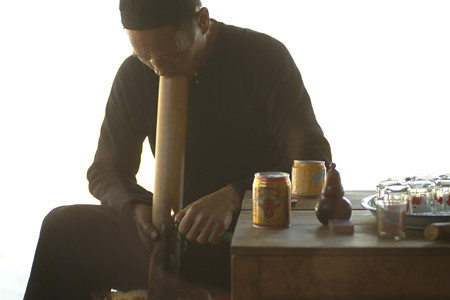A bong is a device that uses water to filter and cool the smoke from burning herb or tobacco. Bongs are one of the most common forms of consuming dried flower, especially among cannabis enthusiasts. But how does a bong work, and what are the benefits and risks of using one? In this blog post, we will answer these questions and more.
The History of Bongs
The word “bong” is said to have been derived from the Thai word “baung,” which traditionally refers to a round wooden tube of bamboo and has also taken on the modern definition of a cylindrical smoking pipe. Some have traced the use of a water pipe to filter and cool smoke back to China’s Ming Dynasty. Other reports show a history of use in Africa, where tribes would build earthen bongs into the ground using the same principles behind modern bongs. There are even accounts of ancient bongs made of pure gold being used by a nomadic warrior race in what’s now Russia.
Bongs are also closely related to the hookah, a type of water pipe generally used to smoke flavored tobacco. Hookahs use a hose as a mouthpiece and can be designed to allow multiple people to enjoy the smoke from a single bowl.
Today bongs can take on many shapes and sizes, but the most common versions are hand-blown from glass by artists who blend science and art, creating masterpieces that are both beautiful and functional. This wasn’t always the case, though. Throughout its evolution, the bong has also been made from materials including hand-carved wood, bamboo, ceramics, and even plastic. Many appreciate the MacGyver-like ability to fashion just about anything into a bong, from Coke bottles to watermelons and everything in between.
Anatomy of the Different Bong Parts
The anatomy of a standard bong can be broken down into five basic parts:
-
Bowl
: The bowl is the bulbous attachment where dried herb or tobacco is loaded and combusted. It’s often removable, allowing it to function as pull- or slide-carburetor. -
Carb
: The carb, short for carburetor, is a small hole that allows the user to clear smoke from the entire chamber of the bong, completing the bong toke. The most common type of carb found on glass bongs is a pull- or slide-carb, which is exposed when the bowl is removed. -
Downstem
: The downstem is the small tube that allows the smoke to travel from the bowl down to the base, where it then percolates through water. -
Base
: The base is the bottom of a bong and can take many shapes, depending on style. A bubble- or beaker-shaped base is often used to create the water chamber in which the smoke cools as it passes through the water. -
Tube
: The tube is the main part of the bong, ending in the mouthpiece. It’s where the smoke travels through after being filtered by the water.
How Do Bongs Work?
The science behind how a bong works is simple: when you light the herb or tobacco in the bowl and inhale, a vacuum is created that sucks the smoke into the chamber. The smoke then bubbles and diffuses through the water, which removes some of the contaminants and makes the smoke smoother. The user can then inhale the smoke from the mouthpiece.
The water in a bong serves two purposes: it cools down the temperature of the smoke, which can otherwise be harsh on your throat and lungs; and it filters out some of the tar and ash that would otherwise end up in your respiratory system. The water also helps to moisturize your mouth and throat, preventing dryness and irritation.
Are Bongs Really Better for Your Lungs?
If you’re looking for a smoother toke, a bong will give you just that compared to smoking herb or tobacco rolled in paper. As expected, the water in a bong eliminates
the dry heat you get from a joint. The effect is often described as being cooler, creamy, and smooth rather than harsh.
This effect can be deceiving, though. While the smoother smoke might feel better on your lungs, you’re still smoking. And that smoke is still filling up your lungs (we’ll spare the lecture on why this is all-around bad news for your health). Sure, a small amount of the bad stuff might get filtered out. But it’s not enough to make much of a difference.
According to the Centers for Disease Control and Prevention and other health organizations, smoke is harmful to lung health regardless of what you’re smoking because of the carcinogens released from the combustion of materials. Smoking herb or tobacco, whether via doobie or bong, can harm lung tissues and cause scarring and damage to your small blood vessels. The tendency to inhale deeply and hold your breath when smoking pot means you’re often exposed to more tar per breath. Plus, bongs are basically a way to get more smoke into your lungs while also making that smoke more pleasant to inhale. All of these aspects make it easy to overdo it when using a bong.
One other risk to keep in mind is related to the use of plastic bongs. Plastics that contain chemicals like BPA and phthalates have been linked to adverse health effects, including cancer.
How to Use a Bong
Using a bong is easy once you get the hang of it. Here are the basic steps:
- Fill the base of the bong with water, enough to cover the downstem but not too much that it splashes into the tube.
- Grind your herb or tobacco and pack it into the bowl. Don’t pack it too tightly or loosely, as this will affect the airflow and combustion.
- Hold the bong in one hand and use a lighter or hemp wick to ignite the herb or tobacco in the bowl. As you do this, place your mouth over the mouthpiece and start to inhale slowly and steadily.
- If your bong has a carb, cover it with your thumb or finger as you inhale. If your bong has a slide-carb, leave it in place as you inhale.
- When you’re ready to clear the smoke from the chamber, either uncover the carb or pull out the slide-carb and inhale sharply. Exhale the smoke and enjoy the effects.
- Repeat as desired, but remember to be responsible and moderate your intake.
How to Clean a Bong
Cleaning a bong is essential for maintaining its functionality and appearance, as well as preventing the buildup of bacteria, mold, and resin that can affect your health and taste. You should clean your bong regularly, ideally after every use or at least once a week. Here are some tips on how to clean a bong:
- Empty the water from the base and rinse it with hot water.
- Remove the bowl and downstem and soak them in a ziplock bag filled with rubbing alcohol and coarse salt. Shake the bag gently to dislodge any residue.
- Pour some rubbing alcohol and salt into the base of the bong and plug the openings with paper towels or cotton balls. Shake the bong gently to scrub the inside with the abrasive mixture.
- Rinse all the parts with hot water until they are clean and clear. You may need to repeat the process if there is still some stubborn residue left.
- Dry all the parts with a paper towel or cloth and reassemble your bong.
Conclusion
A bong is a popular way to enjoy dried herb or tobacco, but it’s not without its drawbacks. While a bong can provide a smoother and cooler smoke than other methods, it’s still harmful to your lungs and health in general. A bong also requires regular cleaning and maintenance to prevent clogging and contamination. If you decide to use a bong, make sure you do so responsibly and moderately, and always choose a high-quality glass piece over a cheap plastic one.
We hope this blog post has helped you understand how a bong works and how to use it properly. If you’re looking for a new bong or other smoking accessories, check out our online store for some great deals and products. Happy smoking!





